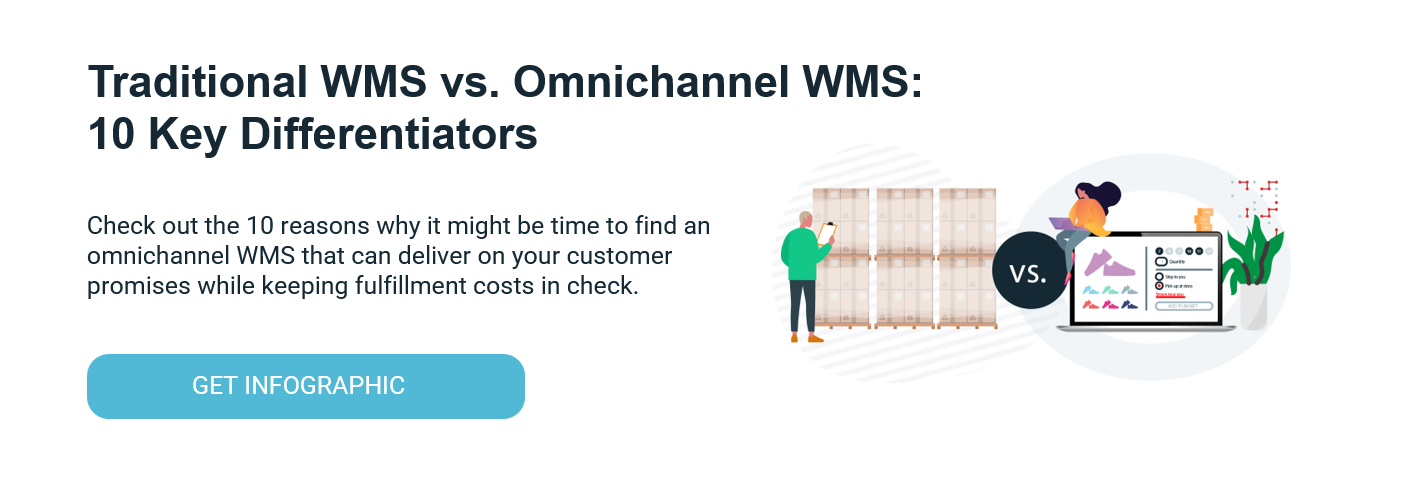Warehouse in a Warehouse: Why You Need to Add an E-commerce Warehouse Management System to Your Retail Operations

So … you have a legacy warehouse management system (WMS) that serves your wholesale/distribution model pretty well. It’s been refined and optimized over time, but it gets the job done and the price (or lack thereof) is right. Perhaps you’ve thought about changing it, however, the ROI just isn’t there yet. Nor do you have the time or resources to do so. Nevertheless, the ship is sailing relatively smoothly.
All of a sudden, you’re hit with a tidal wave (see what I did there?) of e-commerce orders and it’s “bon voyage” to case and pallet picking. Now, your warehouse must handle “eaches” — there are loads of them — and they all have to get out today!
When e-commerce was maybe 10% or 15% of total revenue, you found ways to make this work. You were able to implement a few workarounds, get more temporary warehouse workers during the holidays/Black Friday/Cyber Monday and the job got done. It wasn’t a perfect situation, but it worked.
Nonetheless, the world of retail is changing. E-commerce takes up a much larger share of revenue — 20%, 25%, maybe 30% and growing. You have more orders than you know what to do with. The temporary workers aren’t showing up anymore. The workarounds are clunky. The cost of fulfillment is rising and service levels are down. Your customer service-level agreements (SLAs) are not up to par with your competition. Regardless, you still need your existing WMS for your wholesale business, which works fine for that model.
Does any of this sound familiar? If so, let’s break down your next step options:
- Try and ride it out.
- Do additional development.
- Change out the entire WMS.
- Enhance your operations with an e-commerce warehouse management system
Ride It Out
No one knows for sure if e-commerce orders will stay at the elevated levels it reached during the pandemic. What we do know is that more customers now shop online and have grown accustomed to it. Therefore, it is very likely that e-commerce will take up a larger share of retail revenue that it had historically. This is the new reality retailers need to adjust to and riding it out is not an option — cross this off the list.
Additional Development
If your WMS is homegrown, it’s probably already a “Frankenstein” with add-ons and development done throughout the years. Yes, you could do another modification … but this could be a costly and time-consuming endeavor. Plus, there’s always the risk of breaking a potentially fragile system. If your WMS is from a third party then most likely it’s sold as is and your request to add more functionality will take time and come at a high cost (I shudder just thinking of the testing). Do you really have the budget for this option? Cross this off your list.
Change Your Entire WMS
This option seems a little drastic — don’t you think? Your WMS works fine. All you need is a little more functionality to help you with “eaches” picking. Yes, you can swap out the whole system for a new one if you had a whole year, an extra team and a couple million dollars. This option is perhaps the riskiest of all … probably safe to cross this of your list too.
Enhance Your Operations with an E-commerce Warehouse Management System
This option is what I like to call a warehouse in a warehouse. You have some extra space in your facility — right? A floor that’s not being used, a section that’s empty or maybe even an adjacent building. Grab some yellow paint or tape, draw a giant square on the ground and that’s your new e-commerce fulfillment area. You have the physical, now you need the digital.
The E-commerce Warehouse Management System
An e-commerce warehouse management system is a warehouse management system designed for e-commerce fulfillment. It optimizes pieces picking, has advanced functionality (pick to light, pick to voice, etc.), it can run on almost any device (mobile, scanner, tablet, etc.), it is easy to learn, easy to use and built for any type of fulfillment — manual or automated (robots). It also easily integrates to existing systems.
The premise is simple. Your order source — whether it is an order management system (OMS), electronic commerce platform (ECP), marketplace or enterprise resource planning system (ERP) — sends the order to the e-commerce warehouse management system in your “e-commerce fulfillment facility” (remember the big yellow square painted on the ground) where you have shelves stocked with product ready to be efficiently fulfilled by pickers who are directed to the item location with the help of the e-commerce warehouse management system. Your pickers select the item (based on the method you prefer: wave or batch) and bring it to a packing area for the order to be fulfilled.
The Best of Both Worlds
If this all seems simple, it’s because it is! Your legacy WMS (or ERPs) were not designed and developed for omnichannel retail … so how can you expect them to operate like they would? However, they do serve a purpose and are still viable systems. If you find your WMS can’t cut it in an omnichannel world and you have neither the time, resources nor budget to change it, an e-commerce warehouse management system might just be the best of both worlds.




